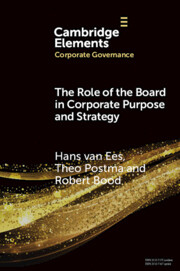Element contents
The Role of the Board in Corporate Purpose and Strategy
Published online by Cambridge University Press: 08 September 2022
Summary
Keywords
- Type
- Element
- Information
- Series: Elements in Corporate GovernanceOnline ISBN: 9781009221092Publisher: Cambridge University PressPrint publication: 15 September 2022
References
- 3
- Cited by

